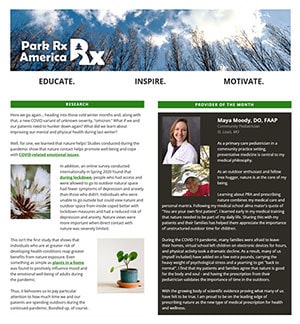How to Prescribe Nature and Send Reminders
Before I jump into the basics of how to prescribe nature, let me start by saying that there's nothing more natural for human beings than to be outside.
Humans have evolved over millions of years, mostly outdoors. It has only been the last few decades where we have seen a major transition, where we now spend most of our time inside. Even so, since we evolved outdoors, nature is not foreign to us, but rather part of our very being. I hope that knowing this will make you feel comfortable when talking to your patients about getting outside more. Plus, in my own experience as well as hundreds of colleagues, prescribing nature is fun and engaging for both our patients and ourselves!
Writing a nature prescription isn't about the healthcare professional finding that magical and perfect place for our patients to spend their time. In contrast to writing a medication prescription, a nature prescription is for the most part "written" by your patient.
The first step to writing a nature prescription is asking the right questions.
"Where do you feel safe and comfortable, outside?" "Where do you like to spend time outdoors?" If you are greeted with silence, feel free to give some general suggestions like backyard, neighborhood park, favorite tree or garden, nearby body of water, playground, or outdoor gym.
This is a good opportunity for you to stay open ended and less specific, when possible. Because our patients are rarely asked these kinds of questions, they will most often be delighted and perhaps surprised that you took the time to ask such a question.
After identifying a place, preferably outside and nature-rich, move onto the second Question.
"What do you like to do outside?" "What kinds of things or activities do you like to do outside or wish to do more outside?"
This is an opportunity for you to listen rather than give advice. However, do consider taking the opportunity to suggest a tweak in the activity to increase its therapeutic potential. For example, if your patient suggests that they walk once a day during their lunchtime for about 20 minutes with earbuds, this might be an opportunity for you to talk about being unplugged, and sharing the science about the therapeutic advantage of hearing the sounds of leaves rustling or nearby animals, as well as the advantage of increasing personal safety by being more aware of your immediate surroundings.
The third and fourth questions are about frequency and duration. "How many times a week, for how many minutes or hours?" It's important for your patient to understand the commitment in terms of time and frequency. This prescription is a "contract" between the two of you and, therefore, one that needs to be realistic in terms of your patient's abilities, desires, and schedule. Your job here is to ask the right question and to suggest/recommend small tweaks to increase the likelihood of success in this prescription and to maximize therapeutic potential.
Balancing between realistic goals and therapeutic potential is something that you will fine tune over time. Be patient with yourself and with your patient. This short but intense conversation about what your patient likes to do outside, where, with whom, for how many minutes/hours, and how many times per week, is one that will change at every visit, similar to adjusting medication doses for maximum benefit. It is rare that any two prescriptions are identical. One size does not fit all, and that's true within the same patient experience, over multiple visits. Like any new intervention you adopt as a provider, there is a learning curve.
As you listen to your patients' responses, and suggest small tweaks, turn this short 1-2 minute conversation into a nature prescription.
Each of these four questions (place, activity, frequency, duration) corresponds to each of the four components of the nature prescription.
The last piece of practical advice I can offer to make this as easy and as efficient as possible, is to have our nature prescribing platform ready to go on your preferred browser (Firefox, Safari, Chrome, etc.) and to be logged in. This way, while this short 1-2 minute conversation is transpiring, you are turning that conversation into a nature prescription simultaneously. This will save you time and frustration.
Reminders

Once you write the prescription, sending a reminder to fill it is easy. Think of this as an addendum to the prescription, which only takes a few seconds, but adds value to the prescription and increases its likelihood of "being filled".
The reminder is not sent from you, but rather from Park Rx America. Therefore, it is necessary to get your patient's verbal consent before setting up a reminder. You can either choose to send a reminder via text or email. You and your patient decide which days of the week a reminder to fill the prescription will be sent. By default, all days of the week will be "checked," because even though at the time of the visit your patient will suggest certain days of the week or a frequency that seems reasonable, we know that these intervals will likely change between one patient visit and the next. Nevertheless, you can change the days of the week to suit your needs and those of your patient.
The last item to complete the reminder is to set the duration of these text or email reminders, which should mirror the length of time between one patient visit and the next. In other words, if you see a patient today and plan to follow up in three months, the reminder should be set for three months.
Taking a moment to make sure that your patient knows to consent and agree to the terms and conditions in the text or email will also increase the likelihood they receive reminders, which in turn increases the likelihood of filling their prescription.

